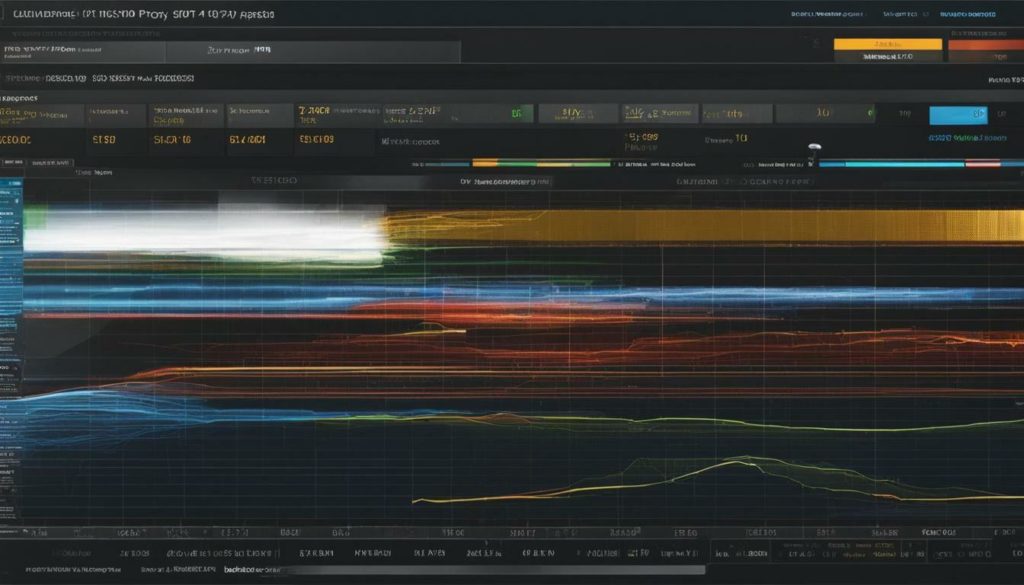Latency in proxy servers can significantly affect the performance of your network, resulting in slower website loading speeds and reduced user experience. It refers to the delay in time between sending a request and receiving a response. Proxy servers act as intermediaries between the user and the server, adding extra stops along the way, which can add to latency. Factors such as the distance between the user and the server, server processing time, and network congestion contribute to latency issues in proxy servers.
- Latency in proxy servers can negatively impact website loading speeds and user experience.
- Factors such as distance, server processing time, and network congestion contribute to proxy server latency.
- Choosing proxy servers located close to the user and the target server can minimize latency.
- Using a proxy server with high throughput can improve loading speeds.
- Other strategies to reduce latency include data compression, minimizing requests for unnecessary files, and distributing requests over multiple IP addresses.
Understanding Latency in Proxy Servers
Latency in proxy servers refers to the delay in time between sending a request and receiving a response, which can be caused by various factors impacting the server’s performance. Proxy servers act as intermediaries between the user and the target server, introducing additional stops along the way. As a result, latency is added to the overall response time.
Factors such as the distance between the user and the server, server processing time, and network congestion contribute to latency issues in proxy servers. The physical location of the proxy server plays a crucial role in determining the amount of latency added. If the proxy server is in close proximity to both the user and the target server, the latency may be minimal. However, if the proxy server is located far away, it can significantly increase latency and impact website loading speeds.
To reduce latency and optimize proxy server performance, it is essential to choose proxy servers that are geographically close to both the user and the target server. This minimizes the distance that data needs to travel, resulting in faster response times. Another factor to consider is the throughput of the proxy server, as higher throughput can improve loading speeds. Additionally, strategies such as data compression, minimizing requests for unnecessary files, and distributing requests over multiple IP addresses can help alleviate latency issues in proxy servers.

Factors Affecting Proxy Server Latency
Several factors can contribute to latency in proxy servers, including the physical distance between the user and the server, the processing time of the server, and network congestion. When a user sends a request through a proxy server, the request has to travel from the user’s location to the proxy server and then to the target server. The physical distance between the user and the proxy server can add significant latency to the overall response time. The farther the user is from the proxy server, the longer it takes for the request to reach the server and for the response to make its way back to the user.
In addition to physical distance, the processing time of the proxy server itself can also contribute to latency. As the proxy server handles multiple requests from different users, it needs to process each request individually, which can take time, especially if the server is overloaded or has limited resources. The server’s processing time can add additional delay to the response time, further increasing latency.
Network congestion is another factor that can affect proxy server latency. Network congestion occurs when there is a high volume of data traffic on the network, leading to slower transmission speeds and increased latency. If the network connecting the user, the proxy server, and the target server experiences congestion, it can significantly impact the response time and overall performance of the proxy server.
| Factors Affecting Proxy Server Latency | |
|---|---|
| Physical distance between the user and the server | The farther the user is from the proxy server, the longer it takes for requests to reach the server and receive responses. |
| Processing time of the server | If the server is overloaded or has limited resources, it may take longer to process each request, adding to latency. |
| Network congestion | High data traffic on the network can lead to slower transmission speeds and increased latency. |
To troubleshoot latency issues in proxy servers, it is important to address these factors. Choosing proxy servers located closer to both the user and the target server can minimize physical distance and reduce latency. Ensuring that the proxy server is well-managed and has sufficient resources can help minimize processing time. Monitoring network congestion and optimizing network settings can also alleviate latency caused by network congestion. By addressing these factors, you can improve proxy server response time and overall performance.

To minimize latency in proxy servers, it is crucial to optimize the transmission speed by implementing certain strategies that address potential bottlenecks. Proxy servers introduce additional stops along the communication path, which can add latency to website loading speeds. However, by following these optimization techniques, you can improve the performance and reduce latency in your proxy server setup.
1. Use High-Performance Hardware
One key aspect of optimizing proxy transmission speed is to ensure that your proxy server hardware is capable of handling high volumes of traffic efficiently. Investing in powerful processors, ample memory, and fast storage options can significantly improve the overall performance of your proxy server and reduce latency.
2. Implement Caching Mechanisms
Caching is a crucial technique that helps minimize latency by storing frequently accessed content locally on the proxy server. By caching static files, such as images and CSS stylesheets, you can significantly reduce the round-trip time for retrieving these files from the destination server. Implementing an effective caching mechanism can greatly improve overall website loading speeds.
3. Enable Compression
Enabling compression at the proxy server level can significantly reduce the bandwidth required to transmit data between the user and the target server. By compressing files before transmitting them, you can effectively minimize the amount of data that needs to be transferred, resulting in faster loading speeds and reduced latency.
Implementing these strategies can greatly optimize proxy transmission speed, minimize latency, and improve overall website performance. By choosing reliable and well-managed proxy servers, investing in high-performance hardware, implementing caching mechanisms, and enabling compression, you can ensure a smooth and fast browsing experience for your users.

Selecting proxy servers that are in close proximity to both the user and the target server is essential for minimizing network latency and improving overall performance. When it comes to proxy server network latency, distance matters. The closer the proxy server is to the user and the target server, the faster the data transmission will be.
One of the main factors that contribute to latency in proxy servers is the physical distance between the user and the server. The farther the user is from the proxy server, the longer it takes for data to travel back and forth, resulting in higher latency. Similarly, if the target server is located far away from the proxy server, it can also increase latency.
To illustrate the impact of proximity on latency, consider the following scenario: Imagine you are in New York and accessing a website hosted in California through a proxy server located in London. The data will have to travel all the way from New York to London and then to California, resulting in significant latency. However, if you use a proxy server located in New York or California, the data transmission will be much faster due to the shorter distance.
| Proxy Server Location | Network Latency |
|---|---|
| New York | Low |
| London | Medium |
| California | Low |
As shown in the table above, selecting a proxy server that is closer to both the user and the target server can significantly reduce latency and improve overall performance. It is important to consider the geographical location of the proxy server and the target site to ensure they are in close proximity. This can be achieved by collaborating with proxy service providers that offer a wide range of server locations to choose from.

By prioritizing proximity in proxy server selection, you can minimize network latency and enhance the browsing experience for users. Faster data transmission leads to quicker response times and improved website loading speeds. Overall, optimizing the performance of proxy servers through proximity selection plays a crucial role in ensuring efficient and seamless web browsing.
Throughput and Loading Speed
Utilizing proxy servers with high throughput can significantly enhance loading speeds and improve the overall performance of your network. When it comes to proxy server performance, throughput plays a crucial role in determining how quickly data can be transmitted between the user and the server.
Throughput refers to the amount of data that can be transferred over a network within a given period. By selecting proxy servers with high throughput capabilities, you can ensure faster data transfer, reducing latency and improving website loading times.
High throughput proxy servers can handle larger volumes of data, allowing for quick transmission of files, images, videos, and other content. This results in a smoother browsing experience for users, with reduced buffering times and faster page rendering.

Additionally, high throughput can also optimize the delivery of streaming media and enhance the performance of real-time applications such as video conferencing or online gaming. The increased data transfer capacity of these proxy servers ensures minimal delays, enabling seamless interactions and better user experiences.
By prioritizing proxy servers with high throughput, you can maximize the efficiency of your network, minimize latency, and deliver content to your users at lightning-fast speeds.
Additional Strategies for Latency Reduction
In addition to optimizing proxy servers’ physical location, there are several other strategies that can be implemented to further reduce latency and improve performance. These strategies focus on enhancing the efficiency and throughput of the proxy server, minimizing unnecessary requests, and distributing load more effectively.
1. Data Compression
Data compression techniques can be employed to speed up transmission and minimize bandwidth usage. Compressing data before sending it through the proxy server reduces the amount of data that needs to be transmitted, resulting in shorter response times. This technique is particularly effective for compressible file types such as text, HTML, and CSS.
2. Minimize Requests for Unnecessary Files
Reducing the number of requests for unnecessary files, such as images and JavaScript, can significantly improve latency. This can be achieved by optimizing website design and development practices, removing redundant files, and consolidating multiple requests into a single request whenever possible. By minimizing the amount of data that needs to be transmitted, overall loading speeds can be improved.
3. Distribute Requests Over Multiple IP Addresses
Distributing requests over multiple IP addresses can help reduce delayed responses and timeouts. By spreading requests across different IP addresses, the load is distributed more evenly, preventing bottlenecks and allowing for faster response times. This strategy is particularly effective for high-traffic websites and can be implemented by using load balancers or proxy server clusters.

Implementing these additional strategies alongside optimizing the physical location of the proxy server can greatly reduce latency and improve overall performance. By compressing data, minimizing unnecessary requests, and distributing load effectively, websites can achieve faster response times and enhance the browsing experience for users.
By consistently monitoring and evaluating proxy server efficiency, it becomes easier to identify any latency issues and troubleshoot them promptly. Regular maintenance and optimization efforts are essential to ensure optimal performance and mitigate latency-related problems. Choosing reliable and well-managed proxy servers is also crucial to avoid potential latency issues and maintain a smooth browsing experience.
Geolocation and Proximity Considerations
Checking the geolocation of both the proxy server and the target site is essential to ensure they are in close proximity, thus minimizing latency. When the proxy server is located far away from the user or the target server, it can introduce significant delays in the transmission of data. By selecting a proxy server that is geographically closer to both the user and the target server, the data packets can travel shorter distances, resulting in faster response times and reduced latency.
In addition to geolocation, proximity considerations also involve factors such as network congestion and server processing time. When a proxy server is overwhelmed by heavy traffic or has limited processing capabilities, it can further contribute to latency issues. In such cases, choosing a well-managed proxy server with high-capacity infrastructure and efficient processing capabilities can help alleviate latency problems.
| Proxy Server Location | Latency |
|---|---|
| Close to User and Target Server | Minimal |
| Far from User or Target Server | Significant |
By evaluating the efficiency of proxy servers and considering geolocation and proximity, you can optimize the performance of your proxy server network and reduce latency. This, in turn, will enhance the browsing experience for users and ensure faster loading speeds for websites.

Remember that the overall impact of latency on web browsing depends on the management and optimization of your proxy servers. While some latency is inherent to the proxy server infrastructure, properly managing and selecting reliable servers can minimize its effects. Choose proxy servers with high throughput and ensure regular monitoring and maintenance for optimal performance.
Managing Latency Impact
While some latency in proxy servers is inevitable, it is crucial to manage and minimize its impact on web browsing to ensure a smooth and efficient user experience. Latency, which refers to the delay in time between sending a request and receiving a response, can greatly affect website loading speeds. When using a proxy server, it is important to implement strategies to reduce latency and optimize performance.
One effective strategy is to choose proxy servers located close to both the user and the target server. Physical proximity between the servers can minimize the delay caused by extra stops along the way. By selecting a proxy server that is nearby, you can significantly reduce the added latency.
| Factors Affecting Proxy Server Latency | Impact |
|---|---|
| Distance between the user and the server | Higher distance leads to increased latency |
| Server processing time | Higher processing time increases latency |
| Network congestion | Higher congestion results in increased latency |
In addition, considering the proxy server’s throughput is essential. High throughput can effectively improve loading speeds and overall performance. By opting for proxy servers with high throughput capabilities, you can minimize latency and ensure a faster browsing experience.
Other latency reduction strategies include using data compression to speed up transmission and minimize bandwidth usage, minimizing requests for unnecessary files such as images and JavaScript, and distributing requests over multiple IP addresses to reduce delayed responses and timeouts. Checking the geolocation of the proxy server and the target site is also important to ensure they are close, further minimizing latency.

- Latency in proxy servers can significantly impact website loading speeds.
- Choosing proxy servers located close to both the user and the target server can minimize latency.
- Opting for proxy servers with high throughput can improve loading speeds and overall performance.
- Implementing strategies such as data compression and minimizing requests for unnecessary files can further reduce latency.
- Checking the geolocation of the proxy server and the target site can ensure minimal latency.
Overall, managing and minimizing latency in proxy servers is essential for a smooth and efficient web browsing experience. By implementing these strategies, you can optimize proxy server performance and ensure faster loading speeds.
Choosing Reliable Proxy Servers
To mitigate latency issues, it is important to carefully choose reliable and well-managed proxy servers that are capable of effectively optimizing performance.
When selecting a proxy server, consider factors such as server location, network capacity, and server load. Opt for servers that are geographically close to both the user and the target server to minimize latency. A proxy server located far away can significantly increase latency due to the additional distance the data has to travel.

Furthermore, it is crucial to choose proxy servers that have high throughput capabilities. Throughput refers to the amount of data that can be transmitted within a given period. A proxy server with high throughput can handle more requests simultaneously and deliver faster loading speeds. By distributing requests over multiple IP addresses, you can reduce delayed responses and timeouts, further optimizing performance.
Additionally, reliable proxy servers should have efficient server processing time. The server processing time refers to the time it takes for the proxy server to process a user’s request. By selecting well-managed servers with efficient processing capabilities, you can minimize the time it takes for the server to handle requests, reducing latency and improving overall performance.
In conclusion, choosing reliable and well-managed proxy servers is essential for reducing latency in proxy servers. Consider factors such as server location, network capacity, throughput capabilities, and server processing time when selecting a proxy server. By making informed choices, you can optimize the performance of your proxy servers and ensure a smooth browsing experience for users.
Ensuring Optimal Proxy Server Performance
To maintain optimal performance, regular monitoring and maintenance of proxy servers are imperative to prevent any potential latency issues. The latency in proxy servers can have a significant impact on website loading speeds, which can lead to a poor browsing experience for users. By implementing the following strategies, you can ensure that your proxy servers are optimized for performance and minimize latency.
Regular Monitoring and Maintenance
Regularly monitoring your proxy servers is essential to identify any potential issues or bottlenecks that may be affecting performance. This includes monitoring server resources, network traffic, and response times. By analyzing this data, you can proactively address any latency issues and make necessary optimizations to enhance overall performance.
Performing routine maintenance tasks such as updating software, applying security patches, and optimizing server configurations can also help prevent latency issues. It is important to stay up to date with the latest technologies and best practices in proxy server management to ensure optimal performance.
Load Balancing and Redundancy
Implementing load balancing techniques can distribute traffic across multiple proxy servers, preventing any single server from becoming overloaded. This not only improves performance but also provides fault tolerance in case one server fails. Load balancing can help reduce latency by evenly distributing incoming requests and preventing bottlenecks.
In addition, setting up a redundant proxy server infrastructure ensures high availability and minimizes downtime. By having multiple proxy servers in different locations, you can effectively manage traffic and prevent latency issues caused by server failures or network congestion.
| Benefits of Regular Monitoring and Maintenance | Benefits of Load Balancing and Redundancy |
|---|---|
|
|
Regular monitoring and maintenance of proxy servers are crucial in ensuring optimal performance and minimizing latency. By proactively addressing any potential issues and implementing load balancing and redundancy strategies, you can enhance performance, improve response times, and provide a seamless browsing experience for your users.

By employing these strategies and consistently monitoring and maintaining your proxy servers, you can effectively optimize their performance and reduce latency. This will not only enhance the browsing experience for your users but also contribute to the overall success of your website or online platform.
Evaluating Proxy Server Efficiency
Continuously evaluating the efficiency of proxy servers is crucial to identify and troubleshoot any potential latency issues, ensuring a seamless user experience. By regularly assessing various performance metrics, you can proactively address any bottlenecks or inefficiencies that may arise in your proxy server setup.
One important aspect to evaluate is the server response time. This metric measures the time it takes for the proxy server to process and respond to incoming requests. Slow response times can indicate performance issues that may contribute to latency. Monitor the average response time over a period of time to establish baseline performance and detect any spikes or anomalies.
Network congestion is another factor that can impact proxy server efficiency. Keep an eye on network utilization metrics to identify periods of high traffic or increased latency. By monitoring these trends, you can make informed decisions about scaling resources or adjusting network configurations to maintain optimal performance.
| Metric | Description |
|---|---|
| Server Response Time | Measures the time taken by the proxy server to process and respond to requests |
| Network Utilization | Monitors network congestion and traffic load to identify potential performance bottlenecks |
| Throughput | Measures the rate at which data is transmitted through the proxy server, impacting overall loading speed |
Throughput, or data transmission speed, is another crucial metric to evaluate. A higher throughput means more data can flow through the proxy server, resulting in faster loading speeds. Regularly monitor the throughput to ensure it remains within acceptable levels and investigate any significant drops that could indicate latency issues or network problems.
By continuously evaluating these performance metrics and making necessary adjustments, you can ensure your proxy server operates at optimal efficiency. This proactive approach will minimize latency issues, improve website loading speeds, and provide a seamless browsing experience for your users.

Proxy server latency can significantly impact network performance, but with proper optimization and management, its impact can be minimized, ensuring a smoother browsing experience. Latency refers to the delay in time between sending a request and receiving a response, and it can be caused by various factors.
One of the key contributors to latency in proxy servers is the physical distance between the user and the server. When the proxy server is located far away from both the user and the target server, it can add significant latency to the connection. Therefore, choosing proxy servers that are close to both ends can help reduce latency.
Another factor to consider is server processing time. If the proxy server is overloaded or has slow processing capabilities, it can further increase latency. To optimize performance, it is important to select reliable and well-managed proxy servers that can handle the incoming requests efficiently.

In addition to physical location and server performance, other strategies can be employed to minimize latency. Utilizing data compression techniques can reduce the amount of data that needs to be transmitted, speeding up the overall transfer. Minimizing requests for unnecessary files, such as images and JavaScript, can also help enhance performance.
Furthermore, distributing requests over multiple IP addresses can prevent delayed responses and timeouts, ensuring a smoother browsing experience. It is also crucial to check the geolocation of the proxy server and the target site to ensure they are in close proximity, reducing latency caused by long-distance connections.
| Factors Affecting Proxy Server Latency | Strategies to Reduce Latency |
|---|---|
| Physical distance between the user and the server | Choose proxy servers close to both ends |
| Server processing time | Select reliable and well-managed proxy servers |
| Network congestion | Utilize data compression techniques |
| Minimize requests for unnecessary files | |
| Distribute requests over multiple IP addresses | |
| Check geolocation for proximity |
By considering these factors and implementing appropriate strategies, proxy server latency can be effectively managed and reduced. This will result in improved network performance, faster loading speeds, and a more seamless browsing experience for users.
Conclusion
Addressing latency issues in proxy servers is crucial for optimizing network performance and enhancing the overall browsing experience. By implementing the recommended strategies, your network can achieve peak performance and ensure efficient and secure data transmission.
Latency in proxy servers is a common issue that can significantly impact website loading speeds. Factors such as the distance between the user and the server, server processing time, and network congestion can contribute to latency issues. Proxy servers act as intermediaries, adding extra stops along the way and potentially increasing latency. However, by choosing proxy servers located close to both the user and the target server, you can minimize latency and optimize transmission speed.
High throughput in proxy servers is also essential for improving loading speeds. Additionally, implementing strategies such as data compression, minimizing requests for unnecessary files, and distributing requests over multiple IP addresses can further reduce latency. Checking the geolocation of the proxy server and the target site is also crucial to ensure they are close, minimizing latency.
Overall, a well-managed proxy server should add some latency to web browsing but should not significantly impact performance if properly optimized. However, it is important to choose reliable and well-managed proxy servers to avoid latency issues. By proactively managing latency and implementing the recommended strategies, you can ensure optimal network performance and provide an efficient and enjoyable browsing experience for your users.
FAQ
Q: What is latency in proxy servers?
A: Latency in proxy servers refers to the delay in time between sending a request and receiving a response. It can affect website loading speeds.
Q: What causes latency in proxy servers?
A: Latency in proxy servers can be caused by factors such as the distance between the user and the server, server processing time, and network congestion.
Q: How do proxy servers add latency?
A: Proxy servers act as intermediaries between the user and the server, adding extra stops along the way. The amount of latency added depends on the physical location of the proxy server.
Q: How can I optimize proxy transmission speed and minimize latency?
A: To optimize proxy transmission speed, choose proxy servers located close to the user and the target server. Additionally, using a proxy server with high throughput can help improve loading speeds.
Q: What are some strategies to reduce latency in proxy servers?
A: Strategies to reduce latency include using data compression, minimizing requests for unnecessary files, distributing requests over multiple IP addresses, and checking the geolocation of the proxy server and the target site to ensure they are close.
Q: Will a well-managed proxy server significantly impact performance?
A: A well-managed proxy server should not significantly impact performance if properly optimized. However, busy or overloaded proxy servers can make the browsing experience miserable.
Q: How can I choose reliable proxy servers?
A: To choose reliable proxy servers, consider factors such as server performance, reliability, and management. It is important to select well-managed proxy servers to avoid latency issues.








